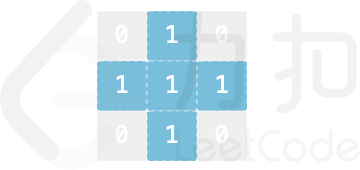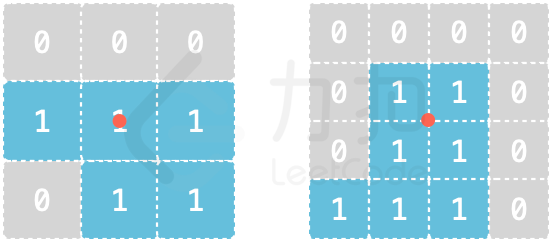C++
Java
Python
Python3
C
C#
JavaScript
Ruby
Swift
Go
Scala
Kotlin
Rust
PHP
TypeScript
Racket
Erlang
Elixir
Dart
monokai
ambiance
chaos
chrome
cloud9_day
cloud9_night
cloud9_night_low_color
clouds
clouds_midnight
cobalt
crimson_editor
dawn
dracula
dreamweaver
eclipse
github
github_dark
gob
gruvbox
gruvbox_dark_hard
gruvbox_light_hard
idle_fingers
iplastic
katzenmilch
kr_theme
kuroir
merbivore
merbivore_soft
mono_industrial
nord_dark
one_dark
pastel_on_dark
solarized_dark
solarized_light
sqlserver
terminal
textmate
tomorrow
tomorrow_night
tomorrow_night_blue
tomorrow_night_bright
tomorrow_night_eighties
twilight
vibrant_ink
xcode
上次编辑到这里,代码来自缓存 点击恢复默认模板
class Solution {
public:
bool composeCube(vector<vector<string>>& shapes) {
}
};
运行代码
提交
python3 解法, 执行用时: 900 ms, 内存消耗: 23.5 MB, 提交时间: 2023-09-05 07:48:47
class Solution:
def composeCube(self, shapes: List[List[str]]) -> bool:
def cal(shape):
res = [0]*48
for i, j in product(range(n), range(n)):
if shape[i][j] == '0':
continue
for turn, (i2, j2) in enumerate([(i, j), (i, n-1-j)]):
for rotate, (x, y) in enumerate([(i2, j2), (j2, n-1-i2), (n-1-i2, n-1-j2), (n-1-j2, i2)]):
for side, (x2, y2, z2) in enumerate([(x, y, 0), (x, y, n-1), (0, y, x), (n-1, y, x), (x, 0, y), (x, n-1, y)]):
res[turn*24+rotate*6+side] |= 1<<(x2*n*n+y2*n+z2)
return res
n = len(shapes[0])
if sum(''.join(shape).count('1') for shape in shapes) != 2*n*n+4*(n-1)*(n-2):
return False
dp = {0}
for i in range(6):
dp = {st|st2 for st in cal(shapes[i]) for st2 in dp if not st&st2}
return bool(dp)
golang 解法, 执行用时: 0 ms, 内存消耗: 2.6 MB, 提交时间: 2023-09-05 07:47:59
// 每条边压缩成二进制
func encode(a [][]byte) (res [4][2]int) {
n := len(a)
for i, b := range a[0] {
res[0][0] |= int(b&1) << i // 正向
res[0][1] |= int(b&1) << (n - 1 - i) // 反向
res[2][0] |= int(a[n-1][i]&1) << i
res[2][1] |= int(a[n-1][i]&1) << (n - 1 - i)
}
for i, r := range a {
res[1][0] |= int(r[n-1]&1) << i
res[1][1] |= int(r[n-1]&1) << (n - 1 - i)
res[3][0] |= int(r[0]&1) << i
res[3][1] |= int(r[0]&1) << (n - 1 - i)
}
return
}
// 顺时针旋转矩阵 90°
func rotate(a [][]byte) [][]byte {
n, m := len(a), len(a[0])
b := make([][]byte, m)
for i := range b {
b[i] = make([]byte, n)
}
for i, r := range a {
for j, v := range r {
b[j][n-1-i] = v
}
}
return b
}
func composeCube(shapes [][]string) bool {
n := len(shapes[0])
a := [6][8][4][2]int{} // [积木][旋转+翻转][边][0-正向/1-反向]
for i, shape := range shapes {
t := make([][]byte, n)
for j, s := range shape {
t[j] = []byte(s)
}
for j := 0; j < 4; j++ {
a[i][j] = encode(t)
t = rotate(t)
}
for _, r := range t {
for j := 0; j < n/2; j++ {
r[j], r[n-1-j] = r[n-1-j], r[j]
}
}
for j := 4; j < 8; j++ {
a[i][j] = encode(t)
t = rotate(t)
}
}
// 判断两条边是否恰好重叠(除了顶角)
MASK := 1<<(n-1) - 2
ok := func(v, w int) bool { return v&w == 0 && (v|w)&MASK == MASK }
type pair struct{ who, rot int }
fill := [6]pair{} // 枚举每个积木以什么旋转/翻转姿势放在哪个面(0-顶面,1234-侧面,5-底面)
vis := 0
var dfs func(int) bool
dfs = func(p int) bool { // 当前考虑的面
if p == 6 { return true }
for cur := 1; cur < 6; cur++ { // 枚举 6 个积木(固定第一个积木放在顶面)
if vis>>cur&1 > 0 { continue }
vis ^= 1 << cur
for rot := 0; rot < 8; rot++ { // 枚举 8 种旋转+翻转的情况
switch p {
case 1:
// 1 和 0 是否有冲突
if !ok(a[cur][rot][0][0], a[0][0][2][0]) {
continue
}
case 2:
// 2 和 0 1 是否有冲突
w, r := fill[p-1].who, fill[p-1].rot
if !ok(a[cur][rot][0][0], a[0][0][1][1]) || // 边是否冲突
!ok(a[cur][rot][3][0], a[w][r][1][0]) ||
a[0][0][2][1]&1 == 0 && a[cur][rot][0][0]&1 == 0 && a[w][r][0][1]&1 == 0 { // 角是否冲突
continue
}
case 3:
// 3 和 0 2 是否有冲突
w, r := fill[p-1].who, fill[p-1].rot
if !ok(a[cur][rot][0][0], a[0][0][0][1]) ||
!ok(a[cur][rot][3][0], a[w][r][1][0]) ||
a[0][0][1][0]&1 == 0 && a[cur][rot][0][0]&1 == 0 && a[w][r][0][1]&1 == 0 {
continue
}
case 4:
// 4 和 0 1 3 是否有冲突
w, r := fill[p-1].who, fill[p-1].rot
w1, r1 := fill[1].who, fill[1].rot
if !ok(a[cur][rot][0][0], a[0][0][3][0]) ||
!ok(a[cur][rot][3][0], a[w][r][1][0]) ||
!ok(a[cur][rot][1][0], a[w1][r1][3][0]) ||
a[0][0][3][0]&1 == 0 && a[cur][rot][0][0]&1 == 0 && a[w][r][0][1]&1 == 0 ||
a[0][0][2][0]&1 == 0 && a[cur][rot][0][1]&1 == 0 && a[w1][r1][0][0]&1 == 0 {
continue
}
default:
// 5 和 1 2 3 4 是否有冲突
w1, r1 := fill[1].who, fill[1].rot
w2, r2 := fill[2].who, fill[2].rot
w3, r3 := fill[3].who, fill[3].rot
w4, r4 := fill[4].who, fill[4].rot
if !ok(a[cur][rot][0][0], a[w1][r1][2][0]) ||
!ok(a[cur][rot][1][0], a[w2][r2][2][0]) ||
!ok(a[cur][rot][2][1], a[w3][r3][2][0]) ||
!ok(a[cur][rot][3][1], a[w4][r4][2][0]) ||
a[cur][rot][0][1]&1 == 0 && a[w1][r1][2][1]&1 == 0 && a[w2][r2][2][0]&1 == 0 ||
a[cur][rot][1][1]&1 == 0 && a[w2][r2][2][1]&1 == 0 && a[w3][r3][2][0]&1 == 0 ||
a[cur][rot][2][0]&1 == 0 && a[w3][r3][2][1]&1 == 0 && a[w4][r4][2][0]&1 == 0 ||
a[cur][rot][0][0]&1 == 0 && a[w4][r4][2][1]&1 == 0 && a[w1][r1][2][0]&1 == 0 {
continue
}
}
fill[p] = pair{cur, rot}
if dfs(p + 1) { return true }
}
vis ^= 1 << cur
}
return false
}
return dfs(1)
}
cpp 解法, 执行用时: 1360 ms, 内存消耗: 7.4 MB, 提交时间: 2023-09-05 07:47:33
class Solution {
int n;
vector<vector<string>> shapes;
// 整个立方体有哪些位置被占用了
bool A[10][10][10];
// 哪些面被占用了
short used[6];
// 每个面的起始位置
int CUBE_BASE[6][3] = {
0, 0, 0,
0, 0, 1,
1, 0, 1,
0, 0, 1,
0, 0, 1,
0, 1, 1
};
// 每个面 xyz 的增加“方向”
int CUBE_DIR[6][6] = {
1, 0, 0, 0, 1, 0,
1, 0, 0, 0, 1, 0,
0, 0, -1, 0, 1, 0,
0, 0, -1, 0, 1, 0,
0, 0, -1, 1, 0, 0,
0, 0, -1, 1, 0, 0
};
// 形状旋转后的起始位置
int SHAPE_BASE[4][2] = {0, 0, 0, 1, 1, 0, 1, 1};
// 形状旋转后行和列的增加“方向”
int SHAPE_DIR[4][2] = {1, 1, 1, -1, -1, 1, -1, -1};
// x:哪个形状
// k:哪个面
// s:哪种旋转
// rc:行列是否交换
// modify:0 = 检查是否占用;1 = 占用;-1 = 取消占用
bool gao(int x, int k, int s, bool rc, int modify) {
for (int a = 0; a < n; a++) for (int b = 0; b < n; b++) {
int i = CUBE_BASE[k][0] * (n - 1) + CUBE_DIR[k][0] * a + CUBE_DIR[k][3] * b;
int j = CUBE_BASE[k][1] * (n - 1) + CUBE_DIR[k][1] * a + CUBE_DIR[k][4] * b;
int z = CUBE_BASE[k][2] * (n - 1) + CUBE_DIR[k][2] * a + CUBE_DIR[k][5] * b;
int si = SHAPE_BASE[s][0] * (n - 1) + SHAPE_DIR[s][0] * (rc ? b : a);
int sj = SHAPE_BASE[s][1] * (n - 1) + SHAPE_DIR[s][1] * (rc ? a : b);
if (shapes[x][si][sj] == '1') {
if (modify == 1) A[i][j][z] = true;
else if (modify == -1) A[i][j][z] = false;
else if (A[i][j][z]) return false;
}
}
return true;
}
bool dfs(int x) {
if (x == 6) return true;
for (int k = 0; k < 6; k++) if (!used[k]) {
for (int i = 0; i < 4; i++) for (int j = 0; j <= 1; j++) {
if (!gao(x, k, i, j, 0)) continue;
gao(x, k, i, j, 1);
used[k] = true;
if (dfs(x + 1)) return true;
used[k] = false;
gao(x, k, i, j, -1);
}
}
return false;
}
public:
bool composeCube(vector<vector<string>>& shapes) {
n = shapes[0].size();
int expected = n * n * n - (n - 2) * (n - 2) * (n - 2);
int actual = 0;
for (auto &shape : shapes) for (auto &line : shape) for (char c : line) actual += c - '0';
if (expected != actual) return false;
this->shapes = shapes;
return dfs(0);
}
};

 {:height="150px"}
{:height="150px"}